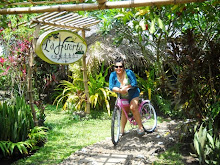monday, 26 march 2012
philippine daily inquirer
 |
| bernadette de los santos 'bidibidi' |
Georgia O’Keeffe became famous for the same subject. Flowers done in
large format and closeup. Instead of flowers presented in bouquets, they
were drawn almost always singly or in sparse numbers, focusing instead
on their anatomical structure. But that was O’Keeffe then in America.
What we have here is Bernadette de los Santos, “Bidibidi” among her
friends, doing her paintings in Baao, Camarines Sur. What sets Bidibidi
apart from O’Keeffe is her treatment of colors in painting her flowers
from the Bicol region, both endemic and naturalized. In Bidibidi’s
paintings, colors are boundless expressions of creativity. Colors are
never subdued. They are permitted their vividness, their lushness. No
apologies here for starkness. Deep blues can exist side by side with the
brightest of yellows. Reds take a radical turn to orange against a blue
background with no transitional hues. Sometimes, Bidibidi does use
pastel colors, as in her “Flower” Series (2000). But she
indiscriminately applies them to all the color palettes in the canvas.
Pastel then no longer becomes a hue, an indication of gradation. Pastel
develops its own expressive value.
In her earlier works exhibited in Gallery of Walter Lee Avery City Hall
(1999) of California, we still observe a nervousness on Bidibidi’s part
as an artist. There is still an apology to mark boundaries, as if to
assure us that it was a conscious decision on her part, to set these
contrasting and opposing colors side by side. But in her later works, as
in the series “Wild About Flowers” (2003), these linear boundaries are
now done away with. Deep colors are made to exist beside each other.
Here, her visual style has finally blossomed.
What makes Bidibidi’s floral paintings excitingly feminist are precisely
these colors, aside of course from the obvious sensual yonic
references, an influence from O’Keeffe. She roots these colors to her
experience of childhood in the Bicol province. Those were days
recollected with a bounty of flowers being strewn, in all their
chromatic glory, at the feet of the Blessed Virgin for the annual Flores
de Mayo. It is to this hometown now that she chooses to go back to, to
promote her love for organic farming. To this end, she has set up
F.A.R.M. (Fabulously & Absolutely Rural Made) to help develop small
and medium enterprises among rural women. At the same time, she opened
up Café des Artes where Bicol artists could exhibit their works. There
is in Bidibidi’s artistic ventures the symbiotic relationship between
the arts and agriculture. Feudal and therefore patriarchal with its long
hacienda history in the county, agriculture is now reclaimed in
Bidibidi’s work as a site of womanhood.
Bidibidi’s vivid colors remind us of the copiousness of life offered
up by the provincial soil. And yes, indeed, our flowers here in the
tropics never scrimp on colors. They lavish us with a sensory overload
of richness sometimes impossible to imagine. Bidibidi now sums up her
journey as an artist in a one-woman inaugural exhibit at La Huerta de
Rosario, Baao, Camarines Sur, on April 1. The exhibit will then be
transferred to Café des Artes where the paintings will stay for a month.
The exhibit is aptly called un rêve de bohême, a bohemian dream, not
just as a hark back to the ’70s but, more importantly, as a celebration
of life in the tropics.







No comments:
Post a Comment